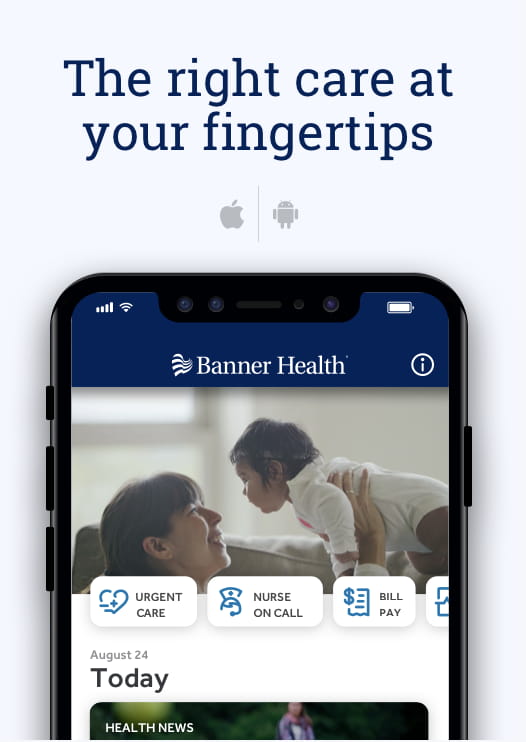While a small cut or scrape is no big deal for some, for those with diabetes, it can lead to serious complications.
When you have diabetes, a number of factors can affect your body’s ability to heal wounds. Premature blockage of the arteries and damage to the nerves, called peripheral arterial disease and diabetic neuropathy respectively, are some of the side effects of diabetes that can play a major role in slowing the healing process.
“A neuropathy can diminish the protective response of the body to pain, such that diabetics may not be aware an injury has even occurred when it happens,” said Darcie Groeper, DO, an internal medicine physician and wound care specialist at Banner Baywood Wound Clinic in Mesa, AZ. “Something as simple as a pebble in the shoe can lead to erosion of the skin and infection. Bones can even fracture in the foot leading to deformities, such as Charcot deformity.”
For this reason (and more!), it’s crucial that if you are diabetic and get a cut, scrape, blister or ulcer, you talk to your health care provider.
What happens when wounds are left untreated
Our skin is the largest organ system in our body and functions as a protective barrier to the outside world. When a wound is present, there is an opening in the barrier, presenting opportunities for bacteria to enter and cause an infection. In those who are diabetic, wounds may take longer to heal which can be especially risky if a wound is left untreated.
“If a cut was left untreated, the lack of blood flow can affect not only underlying tissue but could go down to the bone,” Dr. Groeper said. “This is a serious issue that can lead to amputation of toes, partial foot, below the knee and above the knee.”
This is why immediate treatment is crucial. “Treatment may include opening the arteries, surgery to remove the diseased bone, IV antibiotics, casting the foot, wound dressings and even hyperbaric oxygen therapy to heal,” Dr. Groeper said. “At wound clinics like Banner’s, we take care of these wounds but also teach about prevention.”
Proper treatment of diabetic wounds
If a wound develops, don’t panic. Unfortunately, it’s impossible to totally prevent them (although we’ll share some tips that can help in a minute), but there are steps you can take to start the healing process.
Cleanse the affected area with mild soap and water. Dry the area well and place a topical antibacterial ointment over the area. Then cover the wound with a dressing or bandage. You should also avoid getting it wet in the shower and stay off your foot as much as possible until you get in to see your health care provider.
“You may want to see a wound clinic or a podiatrist who can assist with the healing,” she said. “The wound clinic may send you for blood flow testing, imaging to look for infection, place you on antibiotics, remove any dead tissue or infected skin tissue, and teach you about dressing and how to obtain the best footwear to induce healing.”
Preventing wounds like cuts, ulcers and blisters
While you can’t totally prevent wounds from occurring, there are a number of things you can do to help lower your risk. According to Dr. Groeper, it is a matter of managing your diabetes, foot and nail care and regular examinations.
Diabetes management
Diabetes doesn’t just affect your circulation; it can affect nearly every body system. So, it’s important to keep it in check. “Maintaining your blood sugars as close to your target range as possible can help reduce your risk of all diabetic-related complications,” Dr. Groeper said.
Diabetes management includes getting regular exercise, eating a well-balanced diet, taking your medication as prescribed and quitting smoking. Cigarettes and tobacco contain chemicals that slow healing and are linked to circulatory problems.
Foot and nail care
You can also prevent wounds and ulcers by taking care of your feet and toenails. Here are some things to keep in mind:
- Avoid walking barefoot
- Moisturize your feet (but not between your toes)
- Keep your nails neat and trimmed straight across
- Avoid heating pads on your feet
- Wear high-quality socks to prevent blisters
- Wear proper footwear to protect your feet from accidental scrapes and cuts.
Regular foot exams
Prevention of wounds also means building in a daily home routine of self-examination of your feet and toenails. “By making this as regular as brushing your teeth, you’ll get to know your feet well and spot any changes—even if very small—right away,” Dr. Groeper said.
Check for blisters, dryness, cracking, scaling, red areas, calluses and moisture between your toes. If you notice any of these, make an appointment to see your health care provider.
“Your doctor can assist you to do these things but being diligent in caring for your feet and health will benefit you greatly in the long run and lead to a better quality of life,” Dr. Groeper said.
If you’re in need of diabetic support or wound care, visit bannerhealth.com to find a Banner specialist near you.


